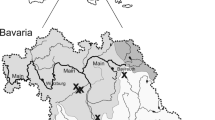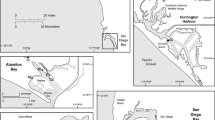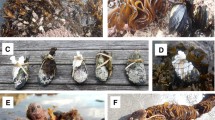Abstract
Aquaculture is a significant vector for the introduction of invasive species worldwide. Understanding factors influencing the proliferation and spread of invasive species from aquaculture sites to native habitats is necessary to develop management strategies aimed at mitigating their spread and subsequent impacts. This study compares population dynamics of the invasive kelp Undaria pinnatifida between mussel farms and a natural reef site in northern New Zealand (36°35′S 175°05′E) and investigates how the abundance of U. pinnatifida on mussel farms, and its presence on adjacent reefs, relates to different environmental variables and physical attributes of mussel farms. Monitoring from 2011 to 2014 found that U. pinnatifida on mussel farms were larger and more seasonally and reproductively persistent compared to populations on adjacent reefs. Region-wide surveys found U. pinnatifida at all mussel farming sites examined (n = 25) and at eight adjacent reefs. Coastal populations were most abundant in reef habitats lacking native macroalgal canopies. Abundance of U. pinnatifida on mussel farms was related to the size of mussels present, but not strongly related to wave exposure, turbidity or spatial attributes of farms. Undaria pinnatifida was found on a number of native reefs adjacent to mussel farms, but its presence on these reefs was not related to the size of farms or distance from shore. These results demonstrate how marine farms provide an optimal environment for the proliferation of invasive species, and management strategies must consider that farms of any size or position relative to shore pose a risk of introducing invasive species to native habitats.







Similar content being viewed by others
References
Agatsuma Y, Matsuyama K, Nakata A, Kawai T, Nishikawa N (1997) Marine algal succession on coralline flats after removal of sea urchins in Suttsu Bay on the Japan Sea coast of Hokkaido, Japan. Nippon Suisan Gakkaishi 63(5):672–680
Anderson M, Gorley R, Clarke K (2008) PERMANOVA+ for PRIMER: guide to software and statistical methods. Primer-E, Plymouth
Aquaculture New Zealand (2011) Greenshell™ mussels—farms. http://aquaculture.org.nz/products/greenshell-mussels/farms/. Accessed 14 June 2015
Brown MT, Lamare MD (1993) The distribution of U. pinnatifida (Harvey) Suringar within Timaru harbour New Zealand. Jpn J Phycol 42:63–70
Campbell ML, Hewitt CL (2013) Protecting high-value areas from introduced marine species. Manag Biol Invasions 4(3):171–189
Carlton JT, Ruiz GM (2005) Vector science and integrated vector management in bioinvasion ecology: conceptual frameworks. In: Mooney HA, Mack RN, McNeely JA, Neville LE, Schei PE, Waage JK (eds) Invasive alien species: a new synthesis. DC Island Press, Washington, pp 36–58
Castric-Fey A, Girard A, L’Hardy-Halos MT (1993) The distribution of Undaria pinnatifida (Phaeophyceae, Laminariales) on the coast of St Malo (Brittany, France). Bot Mar 36(4):351–358
Castric-Fey A, Beaupoil C, Bouchain J, Pradier E, L’Hardy-Halos MT (1999) The introduced alga Undaria pinnatifida (Laminariales, Alariaceae) in the rocky shore ecosystem of the St Malo area: growth rate and longevity of the sporophyte. Bot Mar 42:83–96
Curiel D, Guidetti P, Bellemo G, Scattolin M, Marzocchi M (2001) The introduced alga Undaria pinnatifida (Laminariales, Alariaceae) in the Lagoon of Venice. Hydrobiologica 477:209–219
Davidson AD, Campbell ML, Hewitt CL, Schaffelke B (2015) Assessing the impacts of nonindigenous marine macroalgae: an update of current knowledge. Bot Mar 58(2):55–79
Dean PR, Hurd CL (2007) Seasonal growth, erosion rates, and nitrogen and photosynthetic ecophysiology of Undaria pinnatifida (Heterokontophyta) in southern New Zealand. J Phycol 46:1138–1148
Dodgshun TJ, Taylor MD, Forrest BM (2007) Human-mediated pathways of spread for non-indigenous marine species in New Zealand. DOC research and development series 266, Science and technical publishing, Department of Conservation, Wellington
Edgar GJ, Barrett NS, Morton AJ, Samson CR (2004) Effects of algal canopy clearance on plant, fish and macroinvertebrate communities on eastern Tasmanian reefs. J Exp Mar Biol Ecol 312:67–87
Eno NC, Clark RA, Sanderson WG (1997) Non-native marine species in British waters: a review and directory. Joint Nature Conservation Committee, Peterborough
Farrell P, Fletcher RL (2006) An investigation of dispersal of the introduced brown alga Undaria pinnatifida (Harvey) Suringar and its competition with some species on the man-made structures of Torquay Marina (Devon, UK). J Exp Mar Biol Ecol 334(2):236–243
Fletcher RL, Farrell P (1999) Introduced brown algae in the northeast Atlantic, with particular respect to Undaria pinnatifida (Harvey) Suringar. Helgol Meeresunters 52:259–275
Floc’h JY, Pajot R, Wallentinus I (1991) The Japanese brown alga Undaria pinnatifida on the coast of France and its possible establishment in European waters. J Cons Int Explor Mediterr 47:379–390
Floc’h JY, Pajot R, Mouret V (1996) Undaria pinnatifida (Laminariales, Phaeophyta) 12 years after its introduction into the Atlantic Ocean. Hydrobiologia 326(327):217–222
Forrest BM, Blakemore KA (2006) Evaluation of treatments to reduce the spread of a marine plant pest with aquaculture transfers. Aquaculture 257(1):333–345
Forrest BM, Hopkins GA (2013) Population control to mitigate the spread of marine pests: insights from management of the Asian kelp Undaria pinnatifida and colonial ascidian Didemnum vexillum. Manag Biol Invasions 4(4):317–326
Forrest BM, Brown SN, Taylor MD, Hurd CL, Hay CH (2000) The role of dispersal mechanisms in the spread of U. pinnatifida (Laminariales, Phaeophyceae). Phycologia 39(6):547–553
Gorman RM, Bryan KR, Laing AK (2003) Wave hindcast for the New Zealand region: nearshore validation and coastal wave climate. NZ J Mar Freshw Res 37:567–588
Grulois D, Leveque L, Viard F (2011) Mosaic genetic structure and sustainable establishment of the invasive kelp Undaria Pinnatifida within a bay (Bay of St-Malo, Brittany). Cah Biol Mar 52:485–498
Hay CH (1990) The dispersal of sporophytes of U. pinnatifida by coastal shipping in New Zealand, and implications for further dispersal of U. pinnatifida in France. J Br Phycol Soc 25:301–313
Hay CH, Luckens PA (1987) The Asian kelp U. pinnatifida (Phaeophyta: Laminariales) found in New Zealand harbour. NZ J Bot 25:329–332
Hewitt CL, Campbell ML, McEnnulty F, Moore KM, Murfet NB, Robertson B et al (2005) Efficacy of physical removal of a marine pest: the introduced kelp Undaria pinnatifida in a Tasmanian marine reserve. Biol Invasions 7:251–263
Hunt L, Chadderton L, Stuart M, Cooper S, Carruthers M (2009) Results of an attempt to control and eradicate Undaria pinnatifida in Southland, New Zealand, April 1997–November 2004. Department of Conservation, Invercargill
Inglis GJ, Hayden BJ, Ross AH (2000) An overview of factors affecting the carrying capacity of coastal embayments for mussel culture. Report for Ministry for the Environment No. MFE00505, Wellington
Irigoyen AJ, Trobbiani G, Sgarlatta MP, Raffo MP (2011a) Effects of the alien algae Undaria pinnatifida (Phaeophyceae, Laminariales) on the diversity and abundance of benthic macrofauna in Gulfo Nuevo (Patagonia, Argentina): potential implications for local food webs. Biol Invasions 13:1521–1532
Irigoyen AJ, Eyras C, Parma AM (2011b) Alien algae Undaria pinnatifida causes habitat loss for rocky reef fishes in north Patagonia. Biol Invasions 13:17–24
James K, Middleton I, Middleton C, Shears NT (2014) Discovery of Undaria pinnatifida (Harvey) Suringar, 1873 in northern New Zealand indicates increased invasion threat in subtropical regions. BioInvasions Rec 3(1):21–24
James K, Kibele J, Shears NT (2015) Using satellite-derived sea surface temperature to predict the potential global range and phenology of the invasive kelp Undaria pinnatifida. Biol Invasions 17(12):3393–3408
Johnson CR, Valentine JP, Pederson HG (2004) A most unusual barrens: complex interactions between lobsters, sea urchins and algae facilitates spread of an exotic kelp in eastern Tasmania. In: Heinzeller T, Nebelsick JH (eds) Echinoderms: München. Balkema, Leiden, pp 213–220
Katsanevakis S, Zenetos A, Belchior C, Cardoso AC (2013) Invading European Seas: assessing pathways of introduction of marine aliens. Ocean Coast Manag 76:64–74
Koh CH, Shin HC (1990) Growth and size distribution of some large brown algae in Ohori, east coast of Korea. Hydrobiologica 204(205):225–231
Lobban CS, Wynne MJ (1981) The biology of seaweeds. Blackwell Scientific Publications, Oxford
Lutz-Collins V, Ramsay A, Quijon PA, Davidson J (2009) Invasive tunicates fouling mussel lines: evidence of their impact on native tunicates and other epifaunal invertebrates. Aquat Invasions 4(1):213–220
Mckindsey CW, Landry T, O’beirn FX, Davies IM (2007) Bivalve aquaculture and exotic species: a review of ecological considerations and management issues. J Shellfish Res 26(2):281–294
Meretta PE, Matula VC, Casas G (2012) Occurrence of the alien kelp Undaria pinnatifida (Laminariales, Phaeophyceae) in Mar del Plata, Argentina. BioInvasions Rec 1(1):59–63
Minchin D (2007) Aquaculture and transport in a changing environment: overlap and links in the spread of alien biota. Mar Pollut Bull 55(7):302–313
Minchin D, Nunn J (2014) The invasive brown alga Undaria pinnatifida (Harvey) Suringar, 1873 (Laminariales: Alariaceae), spreads northwards in Europe. BioInvasions Rec 3(2):57–63
Molnar JL, Gamboa RL, Revenga C, Spalding MD (2008) Assessing the global threat of invasive species to marine biodiversity. Front Ecol Envirn 6(9):485–492
Nanba N, Fujiwara T, Kuwano K, Ishikawa Y, Ogawa H, Kado R (2011) Effect of water flow velocity on growth and morphology of cultured Undaria pinnatifida sporophytes (Laminariales, Phaeophyceae) in Okirai Bay on the Sanriku coast, Northeast Japan. J Appl Phycol 23(6):1023–1030
Naylor RL, Williams SL, Strong DR (2001) Aquaculture—a gateway for exotic species. Science (Washington) 294(5547):1655–1656
Neill K, Heesch S, Nelson W (2008) Diseases, pathogens and parasites of U. pinnatifida (Technical Paper No: 2009/44). Minister of Agriculture and Fisheries—Biosecurity New Zealand, Wellington
Nyberg CD, Wallentinus I (2005) Can species traits be used to predict marine macroalgal introductions? Biol Invasions 7(2):265–279
Ojaveer H, Galil BS, Campbell ML, Carlton JT, Canning-Clode J, Cook EJ et al (2015) Classification of non-indigenous species based on their impacts: considerations for application in marine management. PLoS Biol 13(4):e1002130
Olenin S, Elliott M, Bysveen I, Culverhouse PF, Daunys D, Dubelaar GB, Vandekerkhove J (2011) Recommendations on methods for the detection and control of biological pollution in marine coastal waters. Mar Pollut Bull 62(12):2598–2604
Perez R, Lee JY, Juge C (1981) Observations sur la biologie de l’algue japonaise Undaria pinnatifida (Harvey) Suringar introduite accidentellement dans l’Etang de Thau. Sci Peche 325:1–12
Perez R, Durand P, Kaas R, Barbaroux O, Barbier V, Vinot C, Bourgeau-Causse M, Leclerq M, Moigne JY (1988) Undaria pinnatifida on the French coast. Cultivation method, biochemical composition of the sporophyte and the gametophyte. In: Staedler T, Mollion J, Verdus MC, Karamanos Y, Morvan H, Christiaen D (eds) Algal biotechnology. Elsevier, London, pp 315–328
Peteiro C, Freire O (2011) Effect of water motion on the cultivation of the commercial seaweed Undaria pinnatifida in a coastal bay of Galicia, Northwest Spain. Aquaculture 314:269–276
Raffo MP, Eyras MC, Iribarne OO (2009) The invasion of Undaria pinnatifida to a Macrocystis pyrifera kelp in Patagonia (Argentina, south-west Atlantic). J Mar Biol Assoc UK 89(8):1571–1580
Russell LK, Hepburn CD, Hurd CL, Stuart MD (2008) The expanding range of Undaria pinnatifida in southern New Zealand: distribution, dispersal mechanisms and the invasion of wave-exposed environments. Biol Invasions 10:103–115
Sanderson JC (1990) A preliminary survey of the distribution of the introduced macroalga, Undaria pinnatifida (Harvey) Suringar on the East Coast of Tasmania, Australia. Bot Mar 33:153–157
Sanderson JC (1997) Survey of Undaria pinnatifida in Tasmanian coastal waters, January, February 1997. Tasmanian Department of Marine Resources, Tasmania
Savini D, Occhipinti-Ambrogi A, Marchini A, Tricarico E, Gherardi F, Olenin S, Gollasch S (2010) The top 27 animal alien species introduced into Europe for aquaculture and related activities. J Appl Ichthyol 26(Suppl. 2):1–7
Schiel DR, Thompson GA (2012) Demography and population biology of the invasive kelp Undaria pinnatifida on shallow reefs in southern New Zealand. J Exp Mar Biol Ecol 434(435):25–33
Shears NT, Babcock RC (2002) Marine reserves demonstrate top-down control of community structure on temperate reefs. Oecologia 132:131–142
Shears NT, Babcock RC (2004) Community composition and structure of shallow subtidal reefs in northeastern New Zealand. Department of Conservation, Wellington
Shears NT, Babcock RC, Salomon AK (2008) Context-dependent effects of fishing: variation in trophic cascades across environmental gradients. Ecol Appl 18(8):1860–1873
Shibneva SY, Skriptsova AV (2012) Morphological Variability of Undaria pinnatifida (Harvey) Suringar, 1873 (Phaeophyceae, Laminariales) in Peter the Great Bay, Sea of Japan. Russ J Mar Biol 38(5):381–391
Sinner J, Forrest B, Taylor M (2000) A strategy for managing the Asian kelp Undaria pinnatifida: Cawthron Report No. 578, Nelson
South PM, Lilley SA, Tait LW, Alestra T, Hickford MJH, Thomsen MS, Schiel DR (2015) Transient effects of an invasive kelp on the community structure and primary productivity of an intertidal assemblage. Mar Freshw Res. doi:10.1071/MF14211
Subasinghe R, Soto D, Jia J (2009) Global aquaculture and its role in sustainable development. Rev Aquac 1(1):2–9
Thompson GA, Schiel DR (2012) Resistance and facilitation by native algal communities in the invasion success of Undaria pinnatifida. Mar Ecol Prog Ser 468:95–105
Thornber CS, Kinlan BP, Graham MH, Stachowicz JJ (2004) Population ecology of the invasive kelp Undaria pinnatifida in California: environmental and biological controls on demography. Mar Ecol Prog Ser 268:69–80
Thresher RE, Kuris AM (2004) Options for managing invasive marine species. Biol Invasions 6(3):295–300
Valentine JP, Johnson CR (2003) Establishment of the introduced kelp Undaria pinnatifida in Tasmania depends on disturbance to native algal assemblages. J Exp Mar Biol Ecol 295:63–90
Valentine JP, Johnson CR (2004) Establishment of the introduced kelp Undaria pinnatifida following dieback of the native macroalga Phyllospora comosa in Tasmania, Australia. Mar Freshw Res 55:223–230
Voisin M, Engel CR, Viard F, Castilla JC (2005) Differential shuffling of native genetic diversity across introduced regions in a brown alga: aquaculture vs. maritime traffic effects. Proc Nat Acad Sci USA 102(15):5432–5437
Williams SL, Davidson IC, Pasari JR, Ashton GV, Carlton JT, Crafton RE, Fontana RE, Grosholz ED, Miller AW, Ruiz GM, Zabin CJ (2013) Managing multiple vectors for marine invasions in an increasingly connected world. Bioscience 63(12):952–966
Zhan A, Briski E, Bock DG, Ghabooli S, MacIsaac HJ (2015) Ascidians as models for studying invasion success. Mar Biol 162(12):2449–2470
Acknowledgments
The authors thank everyone who helped with field surveys and monitoring: G. Braidwood, I. James, A. Berthelson, K. Rodgers, E. Ainley, P. Caiger, J. Stanley, R. Hughes, J. Walker, B. Doak, J. James, N. White, K. Kenyon, M. James and T. James. The authors also thank Waikato Regional Council and Auckland Council for supporting this research and the reviewers of this work.
Author information
Authors and Affiliations
Corresponding author
Additional information
Responsible Editor: E. Briski.
Reviewed by F. Weinberger and an undisclosed expert.
This article is part of the Topical Collection on Invasive Species.
Electronic supplementary material
Below is the link to the electronic supplementary material.
Rights and permissions
About this article
Cite this article
James, K., Shears, N.T. Proliferation of the invasive kelp Undaria pinnatifida at aquaculture sites promotes spread to coastal reefs. Mar Biol 163, 34 (2016). https://doi.org/10.1007/s00227-015-2811-9
Received:
Accepted:
Published:
DOI: https://doi.org/10.1007/s00227-015-2811-9




